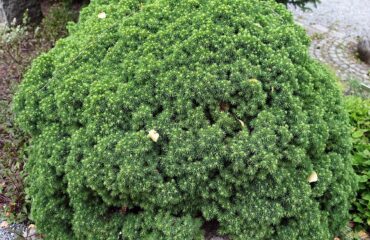Pinus parviflora, commonly known as Japanese White Pine, is an elegant and revered evergreen tree native to Japan. Known for its graceful, fine needles and picturesque form, this pine is highly valued in traditional Japanese gardens, bonsai culture, and as a specimen tree in landscapes. Propagating Pinus parviflora can be achieved through several methods, including seed propagation, cutting propagation, grafting, and layering. Each method offers unique advantages, from preserving specific cultivars to producing a large number of new plants.
Pinus Parviflora (Japanese White Pine) Propagation Methods
1. Seed Propagation
1.1. Seed Collection
Seed propagation is a natural and effective method for producing Japanese White Pine trees with genetic diversity.
- Identifying Mature Cones: Seeds are found within the woody cones that mature on the tree. Collect cones in late summer to autumn when they turn brown and begin to open.
- Harvesting Seeds: Gather cones directly from the tree or from the ground if they have recently fallen. Dry cones in a warm, dry place until they fully open and release the seeds.
1.2. Seed Preparation
Proper seed preparation enhances germination rates.
- Extracting and Cleaning Seeds: Remove seeds from dried cones and clean to remove any attached wings or debris.
- Stratification: Cold stratification helps break seed dormancy. Place seeds in a moist medium like sand or vermiculite and refrigerate at 2-4°C (36-39°F) for 1-2 months.
1.3. Sowing and Germination
After stratification, seeds are ready for sowing.
- Sowing Seeds: Sow seeds on the surface of a well-draining, sandy soil mix, lightly covering with a thin layer of sand or soil.
- Germination Environment: Place seed trays in a bright area with indirect sunlight. Maintain a temperature of 15-20°C (59-68°F) and keep soil consistently moist but not waterlogged.
- Care for Seedlings: Germination typically occurs within 3-6 weeks. Provide seedlings with bright, indirect light and regular watering. Transplant seedlings into individual pots when a robust root system and several true leaves have developed.
2. Cutting Propagation
2.1. Selecting and Preparing Cuttings
Cutting propagation allows for cloning specific Japanese White Pine cultivars.
- Choosing Cuttings: Select healthy, semi-hardwood or hardwood shoots from the current year’s growth. Late summer to early autumn is the best time for taking cuttings.
- Preparing Cuttings: Cut 10-15 cm (4-6 inches) long sections from shoots just below a node. Remove lower needles to expose stem for rooting.
2.2. Rooting Hormones and Planting
Rooting hormones improve pine cutting success rates.
- Applying Rooting Hormone: Dip base of each cutting in rooting hormone powder or gel to stimulate root formation.
- Planting Cuttings: Insert treated cuttings into well-draining rooting medium like peat and perlite or sand. Ensure medium is moist and sterile to prevent fungal infections.
2.3. Rooting Environment and Care
Creating suitable rooting conditions is critical.
- Maintaining Humidity: Use humidity dome or plastic cover to maintain moist environment around cuttings, reducing water loss through transpiration.
- Optimal Conditions: Place cuttings in bright area with indirect light. Maintain temperature of 18-22°C (65-72°F) and keep medium consistently moist but not saturated.
- Monitoring Root Development: Roots typically form within 8-12 weeks, though longer for pine cuttings. Check root growth by gently tugging on cuttings. Once rooted, gradually acclimate new plants to lower humidity and normal light conditions before transplanting into individual pots.
3. Grafting
3.1. Purpose of Grafting
Grafting maintains specific Pinus parviflora cultivars and their desirable traits.
- Advantages: Grafting combines scion’s desired traits with rootstock’s vigor and adaptability, resulting in improved growth and disease resistance.
3.2. Grafting Techniques
Various grafting techniques suit Japanese White Pine.
- Scion and Rootstock Selection: Choose healthy scion from desired cultivar and compatible rootstock, often another Pinus parviflora or vigorous pine variety supporting scion growth.
- Side Grafting: Make slanting cut on rootstock and matching cut on scion. Fit scion onto rootstock and secure with grafting tape or rubber bands.
- Whip and Tongue Grafting: Cut both scion and rootstock with slanting cuts and notches (tongues) to interlock, ensuring strong, stable graft union.
3.3. Post-Grafting Care
Proper care post-grafting ensures graft success and plant health.
- Securing Graft: Use grafting tape or wax to secure graft union, preventing drying and physical damage.
- Healing Environment: Place grafted plants in controlled environment with high humidity and stable temperatures for healing and growth.
- Monitoring and Maintenance: Regularly check graft for union success or failure. Once established, acclimate plant to outdoor conditions. Remove any shoots from rootstock to ensure all growth from scion.
4. Layering
4.1. Purpose of Layering
Layering practically propagates Japanese White Pine, especially for larger, established trees.
- Benefits: High success rate with minimal disturbance to plant, ideal for hard-to-root species.
4.2. Layering Techniques
Ground and air layering are effective for Pinus parviflora.
- Ground Layering: Select low-growing branch, bend down to soil. Incise or remove ring of bark where branch touches soil to expose cambium. Bury section in shallow trench, securing with peg or stone. Cover with soil, leaving branch tip exposed.
- Air Layering: Choose flexible branch, make small cut or remove bark ring to expose cambium. Apply rooting hormone, wrap with moist sphagnum moss. Cover moss with plastic wrap for moisture, securing with ties or tape.
4.3. Post-Layering Care
Care ensures successful layering and new plant establishment.
- Maintaining Moisture: Keep buried or wrapped area moist during rooting period. For air layering, ensure moss remains damp but not waterlogged.
- Monitoring Root Development: Check for root growth after months. Ground layers root within 6-12 months, air layers taking longer.
- Separating and Transplanting: Once root system develops, carefully cut new plant from parent, transplant into pot or garden. Provide water and care as plant establishes.
Conclusion
Pinus parviflora propagation through seeds, cuttings, grafting, or layering offers diverse methods for cultivating this elegant evergreen. Seed propagation fosters genetic diversity and natural growth. Cutting propagation clones specific cultivars, maintaining distinct traits. Grafting combines scion and rootstock advantages for enhanced growth and resistance. Layering provides reliable, low-disturbance propagation. Mastering these techniques enables growers to expand their Japanese White Pine collection, enriching landscapes with its graceful beauty and cultural significance.
Share this article



